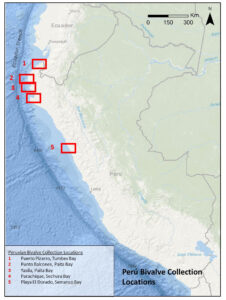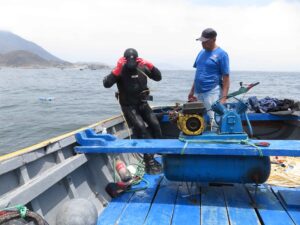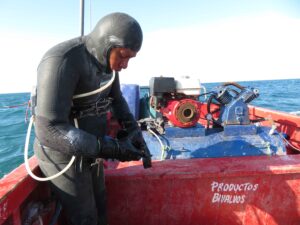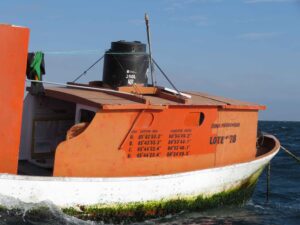
Contributions from the Archaeological Record: Molluscan Climate Proxies and El Niño-Southern Oscillation, North Coast, Peru
Expedition Dates – October 10 – December 18, 2019
Field Team: Frankie St. Amand (UMaine IPhD, CCI)
Expedition Funding Acknowledgement – Dan & Betty Churchill Exploration Fund, Phi Kappa Phi Love of Learning Award, National Science Foundation Graduate Research Fellowship Program
Research Background:
El Niño-Southern Oscillation (ENSO) is a complex climatic phenomenon that has shaped the environment and human behavior on the North Coast of Peru for millennia. In modern times, El Niño (EN) events (a component of ENSO) occur every 3-8 years. Often associated with heavy rains that penetrate this normally arid coastal desert, EN brings flooding, erosion, sea surface temperature (SST) anomalies, and an interruption of marine upwelling that disrupts fisheries’ productivity. EN activity and intensity have varied throughout the Holocene, and abrupt shifts in ENSO patterns during the mid- to late-Holocene are associated with cultural changes on the North Coast (Sandweiss et al., 2007; Sandweiss et al., 2001). The goal of this research is to better understand the use of marine mollusks in paleoENSO reconstructions, particularly how ENSO events affect the growth, distribution, and mortality of different species of bivalves along the Peruvian coast. Information produced by this study has the potential to impact the way climate scientists and archaeologists use fossil bivalves from archaeological sites to reconstruct past climates and environments.
Bivalves are valuable proxies because they inhabited the entirety of the Peruvian coast dating to the Terminal Pleistocene. The human record of exploitation of this marine resource covers this entire period, leaving shells in archaeological sites (Sandweiss, 2003; Sandweiss and Kelley, 2012). Unlike some terrestrial proxies, bivalves directly track changes in coastal SST and upwelling associated with EN events (Carré et al, 2013). Their valves are reliable evidence of ENSO variability because they record fluctuations in stable isotope ratios associated with SST anomalies, seasonal and interannual change in SST (△T) (and thus ENSO variability over time, derived from variance in △T), and upwelling strength associated with El Niño and La Niña events. These changes in isotopic ratios and biomineralization patterns and have been strongly associated with SST and atmospheric pressure in the equatorial Pacific (El Niño 1 + 2 index regions) (Carré et al, 2013). These characteristics enable estimates of seasonal amplitude of the variability of ENSO over time (Carré et al., 2013; Carré et al., 2014; Rollins et al., 1987; Sandweiss et al., 2001). Despite their utility in paleoclimate research, the reliability of certain species and their application in ENSO reconstructions are hotly debated (e.g., Carré, 2005; Jones et al., 2010; Sandweiss et al., 2001).

Research Goals:
The fieldwork on the North Coast and research at the Universidad Peruana Cayetano Heredia in Lima is part of ongoing dissertation research. This research aims to assess the extent to which several bivalve species (Anadara tuberculosa, Argopecten purpuratus, Mesodesma donacium, and Tivela hians) capture evidence of El Niño events in their growth rings via biomineralization scars and variation in oxygen isotopes 16O and 18O. Data produced during field and lab work in October – December 2019 will be analyzed during the spring semester 2020 to better understand how EN effects each species’ growth, distribution, and mortality. These data will better inform climate scientists in the use of archaeological fossil bivalves in climate reconstructions and will determine which fossil bivalves I prioritize in my paleoENSO research.
There are three objectives of this research:
- Comparison of calculated SST from modern A. tuberculosa, A. purpuratus, and M. donacium specimens to SST measurements from the Instituto del Mar del Peru (IMARPE, 2019). Calculated SST will be determined using oxygen isotope ratios measured at the Alabama Stable Isotope Laboratory. This evaluation will help determine to what extent ?18O isotope fractionation during biomineralization is species-dependent (aka “vital effects”) (Carré et al., 2005). This fractionation is already known to be temperature-dependent, and SST is reconstructed using oxygen isotopic ratios in aragonitic shell matrices (Carré et al., 2005; Pérez-Huerta et al., 2013; Grossman and Ku, 1986).
- Determine if A. tuberculosa isotopic signatures in grown rings record EN events. If these mollusks close their valves during SST anomalies associated with EN events, there will not be isotopic evidence of EN, making this species an unreliable indicator of EN events in the archaeological record.
- Determine if T. hians growth rings express tidal or lunar cycles of biomineralization, which could potentially be used to identify EN events, or if they capture statistically significant excursions of ?18O during anomalous SST events.
Methods, Anticipated Results, and Discussion:
I collected modern mollusk species from 4 locations along the Peruvian coast (see Figure 1, locations 2-5) for analysis. Additionally, I am also analyzing modern bivalves collected by a collaborator, Matthieu Carré, from a fifth location (see Figure 1, location 1). I made resin casts, cut thin sections from valves, and polished them in order to conduct a microscope evaluation of their growth lines. After photographing and identifying these lines, I identified lunar growth cycles (approximately 14.8 days) to allow sampling of shells at a monthly resolution. Using a micromill, I drilled microsamples from each monthly growth packet. Shells of each species were an average of 2 years in age, and thus approximately 24 microsamples will be sent for isotopic analysis. The resulting ?18O information will be used to reconstruct monthly averaged SST during the lifespan of the specimens, and will be compared to nearby SST measured by marine monitoring buoys.



Acknowledgements
This fieldwork and research were made possible by an award from the Dan & Betty Churchill Exploration Fund, a Phi Kappa Phi Love of Learning Award, and support from the National Science Foundation Graduate Research Fellowship Program. Support from my advisors Dan Sandweiss and Alice Kelley was crucial to the success of this research project, and collaboration with Matthieu Carré played a large role in the development of these objectives. I am extremely grateful for assistance from Adelina Castillo Morales, lab manager at Universidad Peruana Cayetano Heredia, and for help from Betty Lee and Rebecca Addessi from the Climate Change Institute in travel planning. I’d also like to thank Karl Kreutz for answering questions and providing feedback during the fieldwork portion of this research.
References
Carré, M., Bentaleb, I., Blamart, D., Ogle, N., Cardenas, F., Zevallos, S., … & Fontugne, M. (2005). Stable isotopes and sclerochronology of the bivalve Mesodesma donacium: potential application to Peruvian paleoceanographic reconstructions. Palaeogeography, Palaeoclimatology, Palaeoecology, 228(1-2), 4-25.
Carré, M., Sachs, J. P., Schauer, A. J., Rodríguez, W. E., & Ramos, F. C. (2013). Reconstructing El Niño-Southern Oscillation activity and ocean temperature seasonality from short-lived marine mollusk shells from Peru. Palaeogeography, Palaeoclimatology, Palaeoecology, 371, 45-53.
Carré, M., Sachs, J. P., Purca, S., Schauer, A. J., Braconnot, P., Falcón, R. A., … & Lavallée, D. (2014). Holocene history of ENSO variance and asymmetry in the eastern tropical Pacific. Science, 345(6200), 1045-1048.
DeVries, T. J., & Wells, L. E. (1990). Thermally-anomalous Holocene molluscan assemblages from coastal Peru: Evidence for paleographic, not climatic change. Palaeogeography, Palaeoclimatology, Palaeoecology, 81(1-2), 11-32.
Grossman, E. L., & Ku, T. L. (1986). Oxygen and carbon isotope fractionation in biogenic aragonite: temperature effects. Chemical Geology: Isotope Geoscience Section, 59, 59-74.
IMARPE. (2019). Instituto del Mar del Peru. Retrieved February 15, 2019, from http://www.imarpe.gob.pe/imarpe/
Jones, K. B., Hodgins, G. W., Etayo-Cadavid, M. F., F, C. F. T., & Sandweiss, D. H. (2010). Centuries of marine radiocarbon reservoir age variation within archaeological Mesodesma donacium shells from southern Peru. Radiocarbon, 52(3), 1207-1214.
Pérez-Huerta, A., Etayo-Cadavid, M. F., Andrus, C. F. T., Jeffries, T. E., Watkins, C., Street, S. C., & Sandweiss, D. H. (2013). El Niño Impact on Mollusk Biomineralization–Implications for Trace Element Proxy Reconstructions and the Paleo-Archeological Record. PloS one, 8(2), e54274.
Rollins, H. B., Sandweiss, D. H., Brand, U., & Rollins, J. C. (1987). Growth increment
and stable isotope analysis of marine bivalves: Implications for the geoarchaeological record of El Niño. Geoarchaeology, 2(3), 181-197.
Sandweiss, D. H. (2003). Terminal Pleistocene through Mid-Holocene archaeological sites as paleoclimatic archives for the Peruvian coast. Palaeogeography, Palaeoclimatology, Palaeoecology, 194(1-3), 23-40.
Sandweiss, D. H., & Kelley, A. R. (2012). Archaeological contributions to climate change research: The archaeological record as a paleoclimatic and paleoenvironmental archive. Annual Review of Anthropology, 41, 371-391. DOI:10.1146/annurev-anthro-092611-145941, accessed December 3, 2018.
Sandweiss, D. H., Maasch, K. A., Burger, R. L., Richardson III, J. B., Rollins, H. B., & Clement, A. (2001). Variation in Holocene El Niño frequencies: Climate records and cultural consequences in ancient Peru. Geology, 29(7), 603-606.
Sandweiss, D.H., K.A. Maasch, C.F.T. Andrus, E.J. Reitz, M. Riedinger-Whitmore, J.B. Richardson III, and H.B. Rollins, 2007. Mid-Holocene Climate and Culture Change in Coastal Peru. In Climatic Change and Cultural Dynamics: A Global Perspective on Holocene Transitions, D.G. Anderson, K.A. Maasch, and D.H. Sandweiss (Eds.), San Diego: Academic Press.

